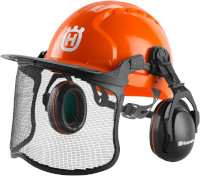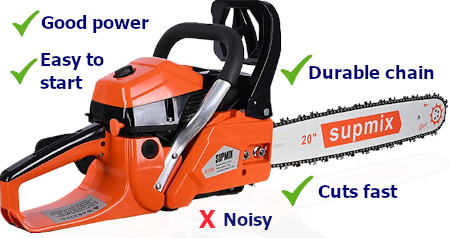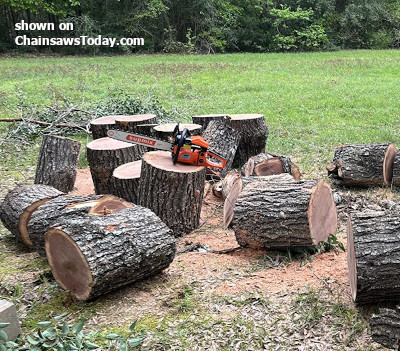 If you’re a regular reader of ChainsawsToday, you know I love getting my hands on various chainsaws and trying them out.
If you’re a regular reader of ChainsawsToday, you know I love getting my hands on various chainsaws and trying them out.
In this case, one of my buddies bought a brand new Ego Power+ CS1804 battery chainsaw. Before he even pulled it out of the box, he let me use it for a weekend!
Ego CS1804 Chainsaw Basics
18-inch bar and chain
LED work lights
11,000 RPM operating speed
IPX4-rated weather-resistant design
Tool-free chain tensioning system (tighten the chain by simply twisting the dial)
Brushless motor for longer life
3/8-inch pitch, .050-inch gauge chain, 62 drive links
5 Ah battery
5-year warranty for the tool
3-year warranty for the battery
14.5 lb operating weight

Pulling this thing out of the box, assembly was pretty quick and painless.
I put bar oil in it, and double-checked the chain tension.
The knobs for both the oil fill and the chain tensioning mechanism are almost comically large. They look in some ways like they belong on a toy, especially in the neon-green color. But there is a method to this madness.
Ego designed these intentionally, so they could be used even when using gloves.
The chain brake is where it needs to be and functions as expected. Clicking the battery in place is simple, and starting the saw (just like any battery saw) is as easy as pushing the button rather than priming a bulb and cranking your arm off on a pull cord.
This thing has plenty of power for its size. It is not super-light, mainly because of the beefy 5 Ah battery. I think they offer a 4 Ah battery too, which might reduce the weight by a pound or two if that’s an issue.
CS1804 Performance
Rather than runtime, which would obviously vary according to how hard you’re pushing the saw, Ego advertises 300 cuts per charge. They standardize that to mean cuts on a 4×4 post, which they presumably test in their lab.
I don’t know how many cuts I got, but I worked the crap out of it and it did fine.
My buddy actually supplied me with two of Ego’s 5 Ah batteries, one came with the saw and one he already had. A cool thing about most of Ego’s products is they can all run off the same battery. Now keep in mind that Ego has different sizes of batteries. This saw comes with the big one (5 Ah), but they are smaller capacity batteries too. Regardless, they all click into place and work fine, whether you’re running the Ego chainsaw, blower, string trimmer, etc.
I ran the saw all day Friday and most of the day Saturday. I didn’t use it continuously, just like a gas saw I would set it down to move wood, haul it to the trailer, pull branches and debris out of the way, or move logs with my peavey.
For the most part, one battery kept up with me just fine. I suspect I could’ve put it on a charger whenever I took a break or hauled stuff to the landfill, and that would’ve been plenty. Having two batteries was icing on the cake, as I was able to keep one on the charger and one on the saw all the time.
Maybe it doesn’t make a difference to you, but after sawing for two days, I had used $0 is gas and 2-cycle oil. I’m guessing that would’ve cost me at least $25 or $35 with a conventional saw. Now, I charged the homeowner over $1,000 for this work, some of which I spent renting trailer and on gasoline driving back and forth to the worksite and the landfill. I’m just saying that the saw itself (just like any battery saw) is cheaper to operate than a gas saw.
I found the chain tensioning mechanism worked fine. Slightly more convenient to use since it’s tool-less, some kudos there.
The saw is pretty quiet, but I still wore hearing protection.
Although I saved on gas and engine oil, of course I still ran through a fair amount of bar and chain oil. The oversized knob makes it easy to check and fill.
I gave the chain a quick file and sharpen a couple of times on Friday, and solid 10 minute refresh Friday night, and just gave it a bit of a tweak once on Saturday. It seems to wear well, and does a good job making the chips fly.

I cut some really thick stuff, and the CS1804 never complained. It has good torque, low kickback, and cuts straight.
It was fairly cool out both days when I was cutting, maybe 50 or 60 degrees F. I can’t really say whether it would have a problem overheating the electric motor on hotter days during long cuts. Just something to watch out for if you think you might use it for hours at a time in a hot climate.
Incidentally, if you need them, here’s a link to the owner’s manual->> HERE, as well as the parts list->> HERE.
Review Verdict
I was surprised by how much I liked this saw.
It is one of the more impressive battery chainsaws I’ve used.
I don’t like the looks of it, like I mentioned it looks sort of toy-like and plastic-y. But I definitely like it’s performance.
I am thinking about buying one of my own!


 Or maybe you live on a tropical island and you don’t even own a winter coat!
Or maybe you live on a tropical island and you don’t even own a winter coat!




 In many cases, once it’s lost, it never comes back. Also, it can be cumulative. The more exposure you have to loud noise, over time it will absolutely begin to affect your hearing.
In many cases, once it’s lost, it never comes back. Also, it can be cumulative. The more exposure you have to loud noise, over time it will absolutely begin to affect your hearing.




 Right out of the box, this thing started right up and gave me no issues cutting.
Right out of the box, this thing started right up and gave me no issues cutting.



 This thing starts easily. I have heard some folks complaining about getting it started, but I often wonder if those are people that complain about starting all saws. I had no trouble hot or cold, a few pulls of the cord and it was rip-roaring.
This thing starts easily. I have heard some folks complaining about getting it started, but I often wonder if those are people that complain about starting all saws. I had no trouble hot or cold, a few pulls of the cord and it was rip-roaring.



 You will no longer be uneducated, or have to rely on random nextdoor neighbor guesstimates. You are going to get the real, accurate scoop…
You will no longer be uneducated, or have to rely on random nextdoor neighbor guesstimates. You are going to get the real, accurate scoop… Maybe you’re ordering wood and the guy is going to sell you a certain number of cords for $100. Maybe you’re cutting or splitting wood, and you’re wondering how much there is to cut or split. Regardless, you don’t say “a truckload” or “about 500 pounds”. You use the number of cords to describe the amount.
Maybe you’re ordering wood and the guy is going to sell you a certain number of cords for $100. Maybe you’re cutting or splitting wood, and you’re wondering how much there is to cut or split. Regardless, you don’t say “a truckload” or “about 500 pounds”. You use the number of cords to describe the amount.
 You can use those dimensions to help you estimate the volume of wood in uncut, unsplit logs too. If you have a pile of logs that are 16 feet long and roughly 4 feet high and 4 feet wide, then you would extrapolate that to mean there are 2 cords of wood there. Make sense?
You can use those dimensions to help you estimate the volume of wood in uncut, unsplit logs too. If you have a pile of logs that are 16 feet long and roughly 4 feet high and 4 feet wide, then you would extrapolate that to mean there are 2 cords of wood there. Make sense? I have been watching with great interest as electric log splitters have gotten better and more available over the years. There are a lot of great things you get with electric, even though it has some drawbacks too.
I have been watching with great interest as electric log splitters have gotten better and more available over the years. There are a lot of great things you get with electric, even though it has some drawbacks too.
 I’m no dummy, I’m pretty handy and can put pretty much anything together. But when they say it may require two people to assemble… they ain’t lying.
I’m no dummy, I’m pretty handy and can put pretty much anything together. But when they say it may require two people to assemble… they ain’t lying.


